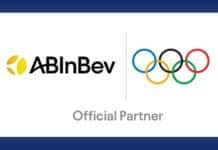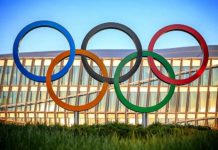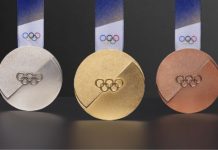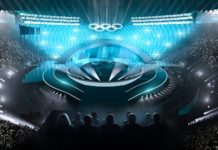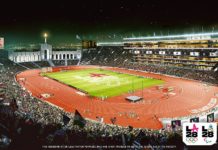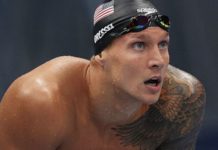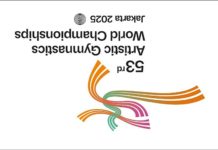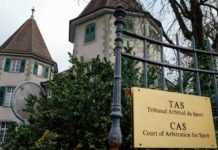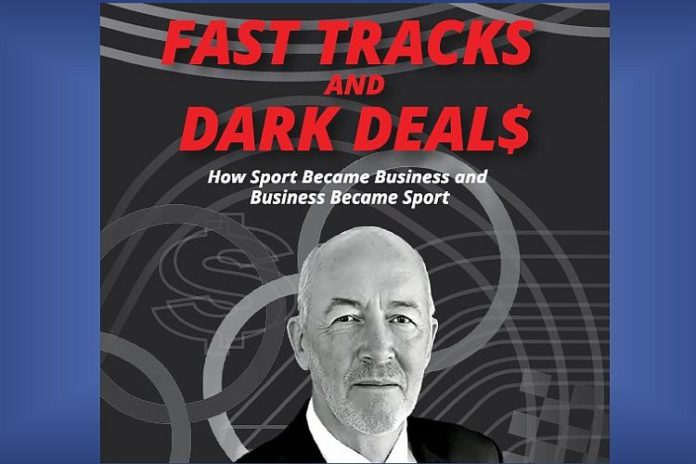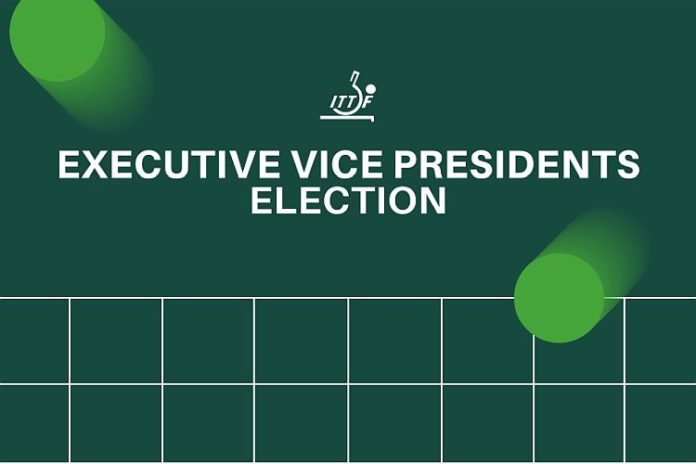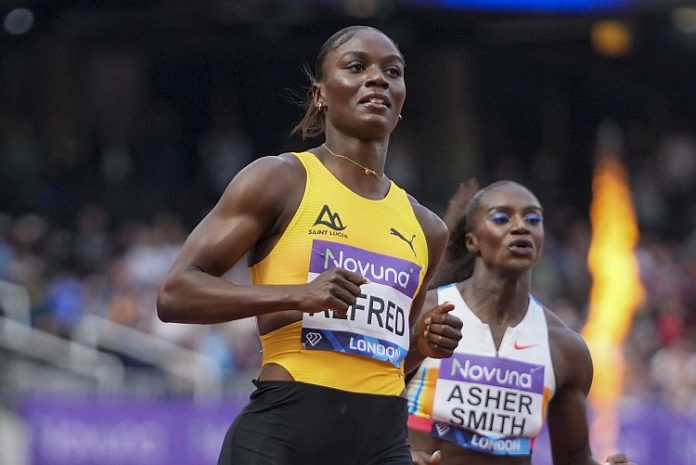★ The Sports Examiner: Chronicling the key competitive, economic and political forces shaping elite sport and the Olympic Movement.★
★ To get the daily Sports Examiner Recap by e-mail: sign up here! ★
≡ “FAST TRACKS AND DARK DEAL$” ≡
If you’ve always wanted to be an invisible witness in the room when critical decisions are made, or when a crisis hits and has to be resolved, then Fast Tracks and Dark Deal$ from former International Olympic Committee marketing director Michael Payne (IRL) is for you.
Across 585 pages, he offers both a historical panorama and a detailed analysis of how he grew into one of the most successful sports marketers ever and how the International Olympic Committee rocketed to financial stardom in the 20 years following the 1984 Olympic Games in Los Angeles.
He started off as a Freestyle skier, long before it made the Olympic Winter Games program and soon figured out that he didn’t just want to be part of an aerial skiing show, he wanted to run his own show. He did, but with plenty of challenges – including finding sponsors – and he realized:
“I was fortunate enough to stumble upon the inception of a business that I didn’t even realise was a business. Sports marketing wasn’t a field. It was barely a phrase. It was just a handful of dreamers, risk-takers and opportunists attempting to create something from nothing.”
By 1979, Payne decided to put the skis away and try his hand at sports marketing and looked to the emerging players in the market, U.S.-based talent and television agency International Management Group (IMG) and Britain’s emerging sponsorship agency, West Nally. And then there was the German Horst Dassler, the driving force behind the worldwide market leaders in shoes and sporting apparel, adidas, whose influence was so deep that “He operated in the shadows, yet everyone knew where the strings were being pulled.”
Dassler and Patrick Nally created a company, SMPI Monaco, to marry events and sponsors, starting with FIFA and the 1978 FIFA World Cup in Argentina. While Payne struck out at IMG, he scored a three-month trial in late 1979 at West Nally as a junior account executive. And when the London Marathon was founded in 1980, Payne found success in attracting sponsors for the first race in 1981.
The book is replete with recollections of problems and solutions. For the first London Marathon, what was supposed to be a finish-line arch – a “gantry” in British English – was built essentially as a solid wall! Payne order it rebuilt in real time and it was, just in time. Wrote Payne:
“That day, I learned a lesson that would stay with me for the rest of my career: Verify, verify, verify. Never trust that even the most carefully drawn-up plans will work and never assume they will magically fall into place on that day.”
Then there was the famed Bislett Games track & field meet in Oslo (NOR), where Payne and West Nally had arranged for Silk Cut – a British cigarette brand – to be a sponsor for its new “Silk Cut Holidays” travel program. The problem was that tobacco advertising was banned in Norway and the Norwegian Health Minister demanded that all of its signage be removed … during the meet! It was … just as soon as the meet ended.
By 1982, SMPI Monaco imploded, Nally was out and Dassler founded International Sport & Leisure (ISL) in Lucerne (SUI) and Payne moved over in 1983 and was matched with a new undertaking with the International Olympic Committee, which was starting up its own sponsorship concept after seeing the success of Peter Ueberroth and the Los Angeles 1984 Olympic organizers, who had enjoyed enormous, pioneering success in this area. Payne knew very little about the IOC, but found out quickly:
“The IOC was small, consisting of one executive director, a couple of managers, and twenty-seven secretaries. It operated from a small, creaky eighteenth-century chateau, Chateau de Vidy, situated on the shoes of Lake Geneva in Lausanne. I had also assumed the IOC was wealthy, with multiple revenue sources. In reality, it was on the verge of bankruptcy.”
What is today the IOC’s “TOP” Olympic sponsorship plan was roughed out by the end of 1983 and when ISL and Payne began talking to potential partners in 1984, “the reaction was far from encouraging.” But there was a clear consensus from potential sponsors that a worldwide sponsorship concept where all rights – around the world – could be bought at once might be worthwhile.
The ISL came up with 44 possible categories for the first TOP program – pretzels were on the list – and Dassler came up with a sales target of $300 million. Many National Olympic Committees agreed but the U.S. Olympic Committee was hardly interested, but “eventually agreed, but only if they secured full veto power over every aspect of the programme and a guaranteed board seat on whichever entity would manage TOP.”
During Payne’s first Olympic Games experience at the Sarajevo 1984 Winter Games, he was working with Japanese executive Ipei Inoh from the ad giant Dentsu, and they had to backtrack to pick up Inoh’s passport, left in a cafe an hour’s drive behind them. Payne supported Inoh and wrote:
“That experience taught me a lesson that would become crucial for the rest of my career, understanding and respecting other cultures isn’t about master formal etiquette or quoting guidebooks; it’s about empathy; stepping into another person’s shoes, especially when it matters most. It sounds simple, but few people practice it, and they wonder why they repeatedly struggle in international negotiations.”
Payne paid homage to the success of the 1984 Games and the Ueberroth’s sponsorship revolution and the organizing committee’s financial surplus of $232.5 million (Payne quotes various figure on the surplus in the book, but $232.5 million is the correct amount). The bottom line:
“Cities that had once shunned the Olympic brand were now racing toward it; within two years, Seoul and Barcelona were proposing nine-figure legacy plans, and by the 1990s, the IOC’s mailbox overflowed with lavish city prospectuses, called ‘bid books.’ Thanks to an eager Southern California travel agent and a razor-thin board vote, the modern Games recognised the power of entrepreneurial show business and never looked back. …
“Ueberroth’s success in delivering the 1984 Games didn’t just revitalize the Olympic Movement; it also fundamentally altered the trajectory of world sport. For the first time, the Olympic Games had proven that they could be staged without bankrupting a city or draining public coffers, and even more remarkably, they could produce a surplus.”
In terms of the TOP program, the ‘84 Games “it affirmed that the vision behind TOP could succeed. We had just witnessed, in real-time, a living case study of everything we hoped to build.”
Payne had been hired at ISL to be the liaison with the Seoul organizers of the 1988 Olympic Games on Korea, but wrote “I was twenty-six years old. And I was in way over my head.”
The TOP program had to obtain two sponsors by March 1986, or the project – seen as a trial – would be disbanded. By late 1985, nothing and multiple LA84 sponsors – such as American Express – had passed. Then, Visa responded with some enthusiasm, as did 3M and Dentsu turned by electronics giant Matsushita – Panasonic – and the project was off and running. Four more joined and TOP I produced $95 million in rights fees. Good enough, but Dassler only saw the beginning, dying of cancer in 1987.
The outcome was startling:
“Visa and 3M, new to sports sponsorship and free of any preconceived notions, set out to redefine the playbook. They didn’t just slap the Olympic rungs onto ads; they made the Games central to their marketing strategies, weaving Olympic themes into advertising, public relations, internal communications, product development, and packaging. The Olympics became the heart of the message, not a late add-on to existing campaigns. The results astonished everyone.”
Visa’s pitch was explosively simple: “If you’re going to the Olympics, bring your camera and your Visa, because the Olympics don’t take place all the time, and this year [1988], they don’t take American Express.”
That was all in the first 110 pages! Payne goes on with story after story, crisis after crisis and how it all got solved. And lots more, such as how the release of pigeons at the 1988 Seoul Games was the last time it happened, after too many settled on the rim of the Olympic cauldron and were killed when the flame was lit. There’s a lot more to the story.
In 1988, Payne moved from ISL directly to the IOC itself, and became the marketing and broadcast rights director to 2004. There were all kinds of sponsor attempts at on-field exposure by Ray-Ban, Mars/M&Ms, Chevrolet, McDonald’s and many others (almost all were defeated) – ambush marketing attempts of every kind, defeated by Payne and IOC member Dick Pound (CAN), the head of the IOC’s Marketing Commission, which oversaw the TOP program.
The narrative glides the reader through the triumphs and tribulations of the Games that followed:
● Atlanta’s dysfunctional relationship with the Atlanta Committee for the Olympic Games in 1996, the problems with results, security, transportation, design and sponsor difficulties with IBM, McDonald’s, Nike, and others.
● How Payne helped trick the Australian government into putting the Olympic Rings onto the Sydney Harbour Bridge.
● How the Salt Lake City bid scandal started, mushroomed out of control and how the IOC worked to manage the damage and ultimately came out reformed and better governed. And dealing with a TOP sponsor-turned-critic in American insurance giant John Hancock.
● How a lunch with an ABC executive started the change of the Winter Games from the same year as the Olympic Games to two years after.
● “It was another important lesson, don’t call your boss with problems; call them with solutions.”
In the second half of the book, Payne went into detail on the race for the U.S. television rights for the as-yet-unassigned 2010 Winter and 2012 Olympic Games, in a fascinating showdown between ABC, CBS. FOX and eventual winner NBC.
Payne covers a lot more, including a long reflection and some good stories on Olympic bidding, on why the IOC’s “clean venues” policy remains important, the importance of the Olympic torch relay and comments on all of the Games through the Covid-impacted Games of Tokyo 2020 and Beijing 2022.
He covers his work after he left the IOC in 2004, working with F1 from 2004-16 and as a consultant on Olympic bids, but also as an advisor to International Federations, for example for volleyball and modern pentathlon, and comments on boxing, golf, wrestling and more.
Payne, now 67, observed: “Relationships matter more than rights, vision matters more than process, and timing is always the one variable you can never quite control.”
Chapter 21 on what the future holds is interesting, fun and totally speculative, and Payne’s top-10 lists in the appendices are sure argument-starters.
This is Payne’s third book and easily his broadest in scope. Fast Tracks and Dark Deal$ is being released on Monday, 17 November.
¶
★ Receive our exclusive, weekday TSX Recap by e-mail by clicking here.
★ Sign up a friend to receive the TSX Recap by clicking here.
★ Please consider a donation here to keep this site going.
For our updated, 850-event International Sports Calendar for 2025, 2026 and beyond, by date and by sport, click here!



